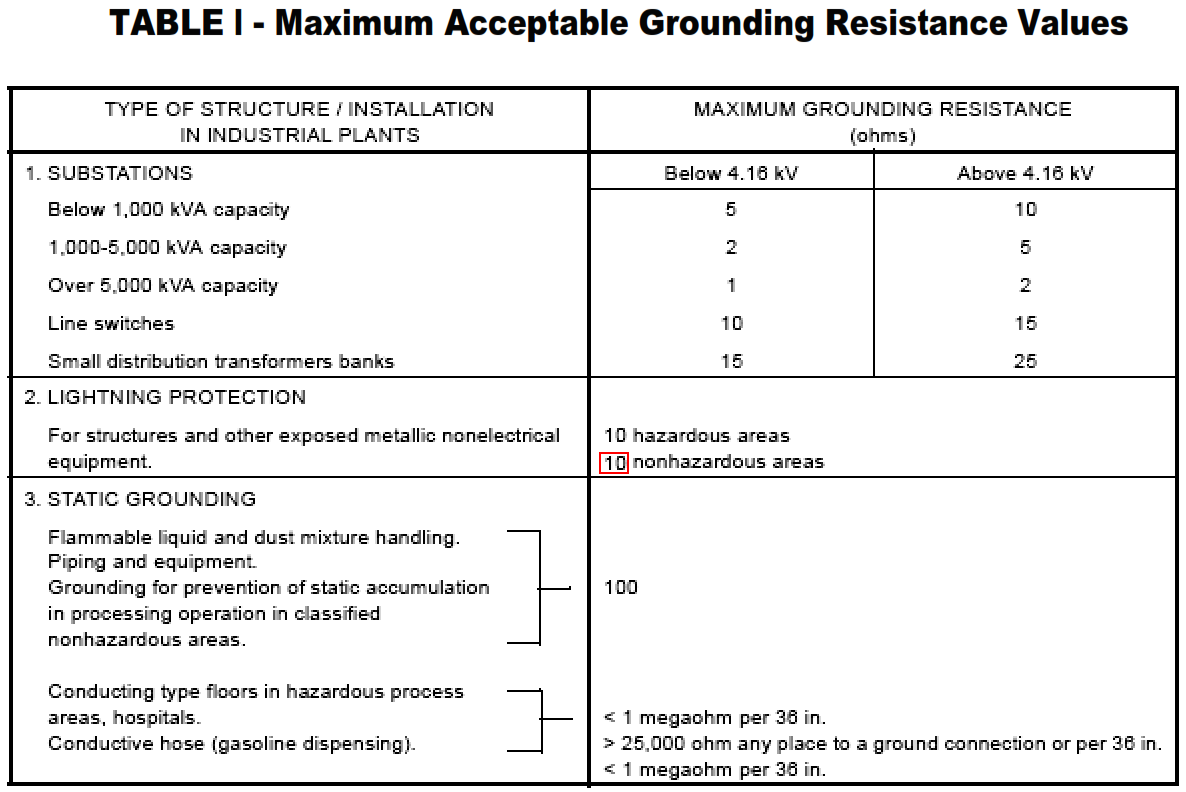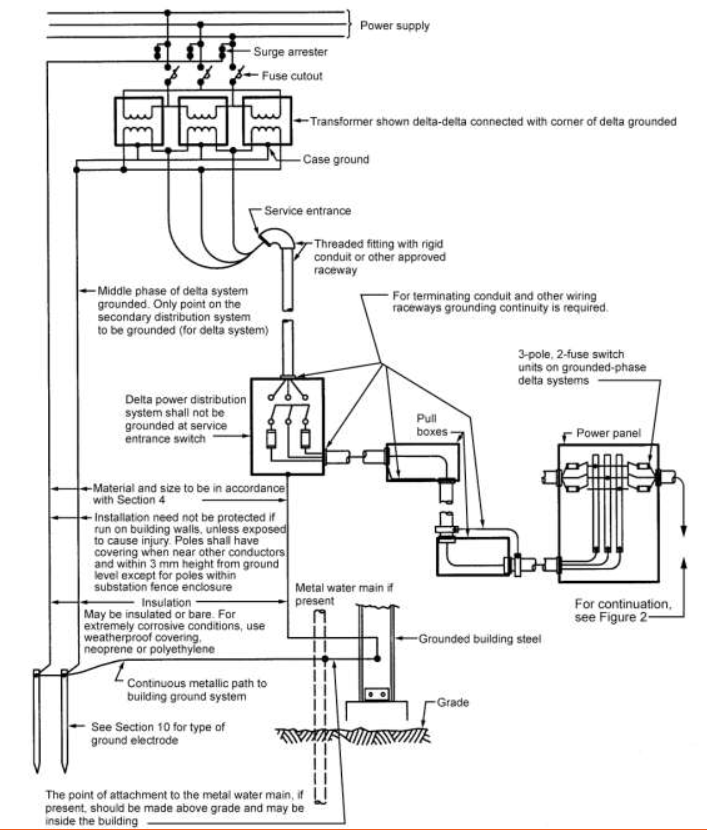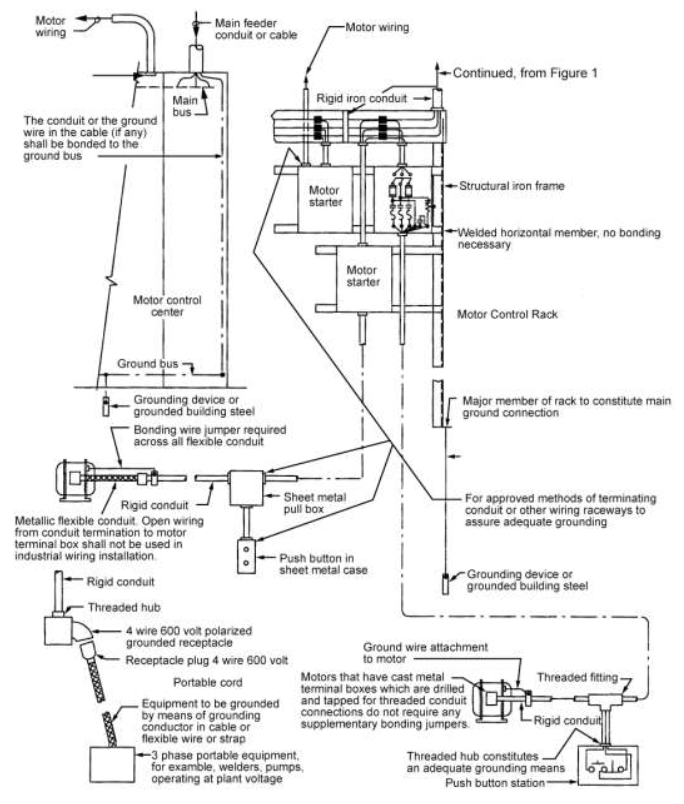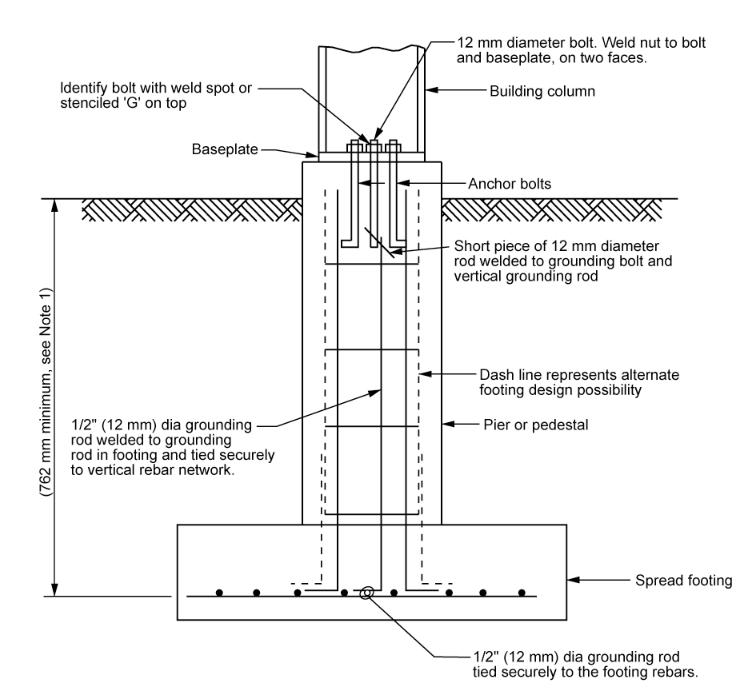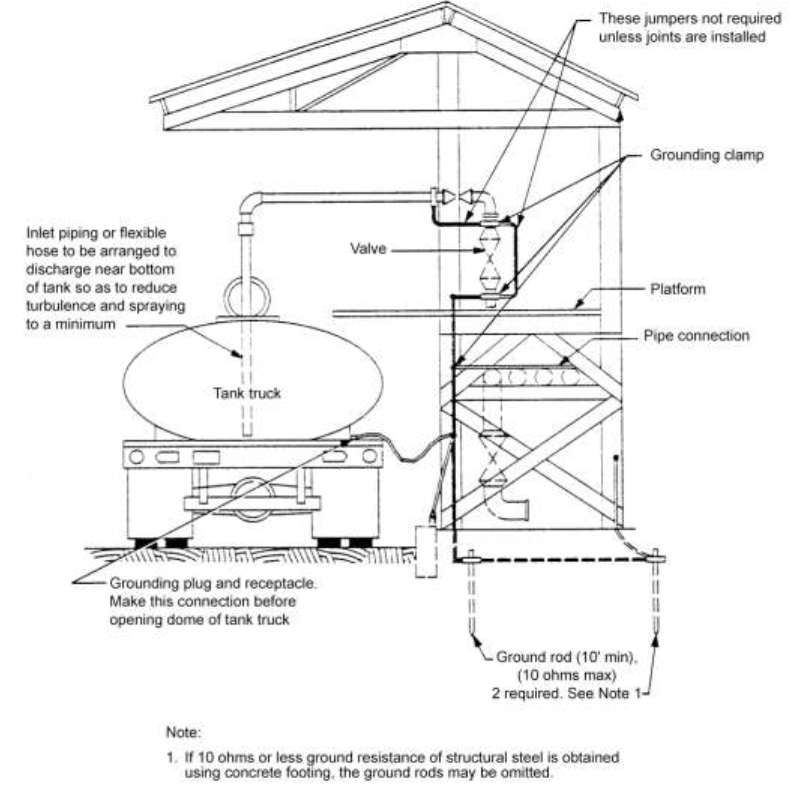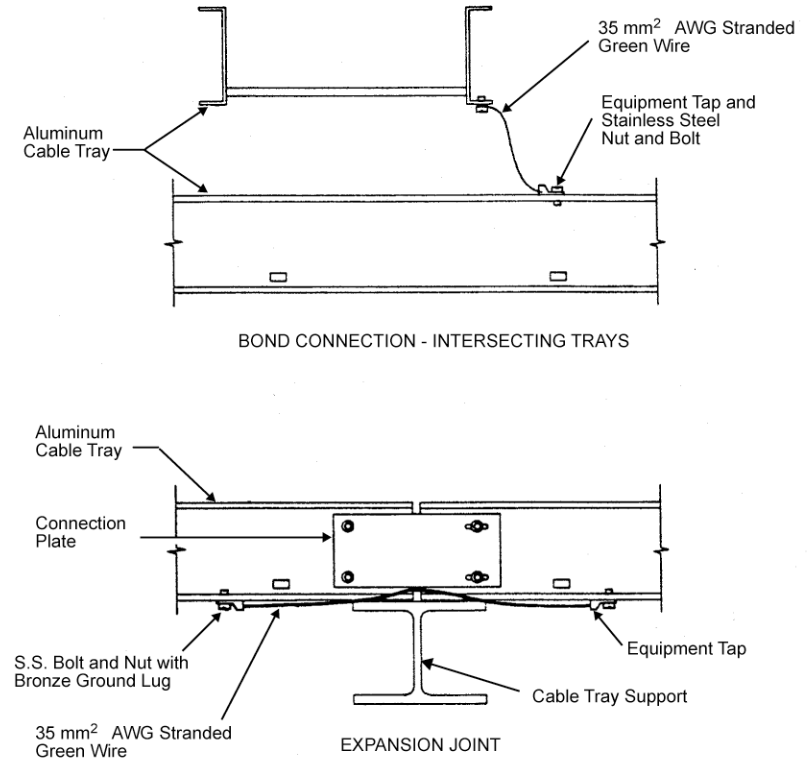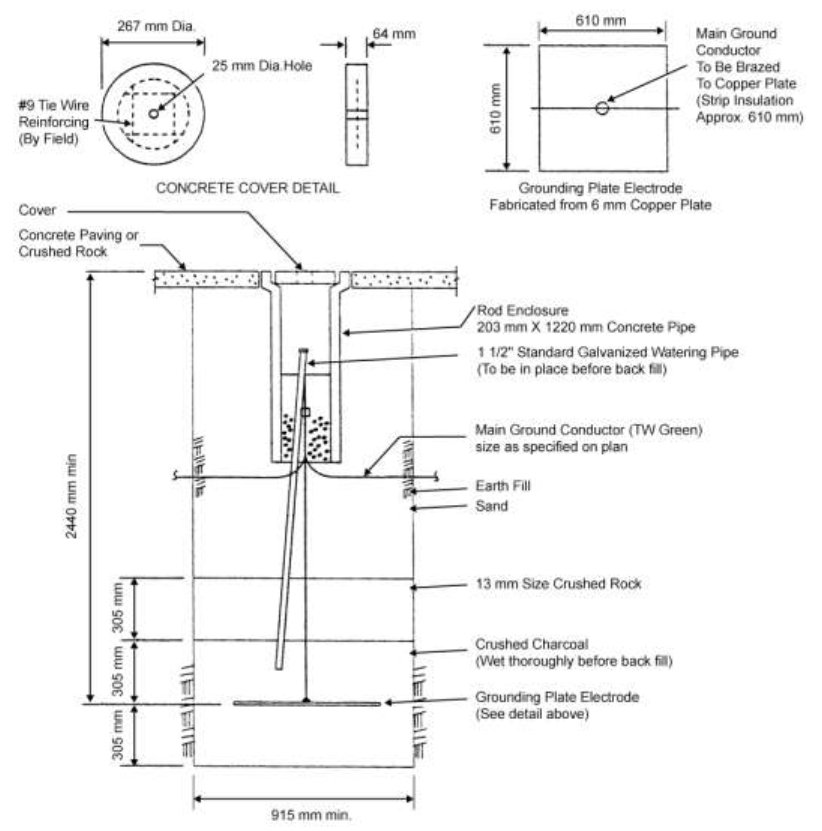This article is about installation requirements for grounding and bonding electrical systems, raceways, enclosures, and equipment. The safety of personnel and the protection of electrical systems and equipment is paramount in the installation of electrical bonding and grounding. Injury to personnel and damage to equipment are possible from dangerous fault currents and excessive voltage surges due to lightning strikes or transformer failures. Using appropriate installation techniques is vital to ensure the integrity of the system. Main keywords for this article are Bonding and Grounding, Electrical Bonding Requirements, Grounding Electrodes, Grounding Requirements for Hazardous Classifications. Main keywords for this article are Bonding and Grounding, Electrical Bonding Requirements, Installation of Grounding and Bonding Conductors, Grounding Electrodes.
Bonding and Grounding
References
American National Standards Association / Institute for Electrical and Electronics Engineers (ANSI/IEEE)
ANSI/IEEE 142 Grounding of Industrial and Commercial Power Systems
National Fire Protection Association (NFPA)
NFPA 70 National Electrical Code,2008
NFPA 77 Recommended Practice on Static Electricity
European Industrial Gases Association (EIGA)
Oxygen Pipeline Systems- IGC Doc 13/02/E
Electrical Bonding Types
- Direct bonding consists of a permanent metal-to-metal contact inherent in the equipment for use in those locations where it may be desirable to disconnect the jumper at times for testing the maintenance purposes, and where clearances shall be maintained for mechanical reasons. The direct bond made by welding or brazing is most effective. Jumper bonding with suitable clamps and fittings may be classified as a semipermanent joint. The contact surfaces shall be clean.
- Jumper bonding consists of a bonding conductor and a suitable clamp or a bolted connection for use in those locations where it may be desirable to disconnect the jumper for maintenance purposes.
- Continuous relative bonding is required, for example, to bond a rotating shaft with a brush secured in contact with the shaft and a jumper wire connection for bonding.
Electrical Bonding Requirements
- All bonding connections, except those consisting of a permanent metal-tometal contact accomplished by welding or brazing, shall be made with compression connectors, clamps, or other approved means. Connection devices or fittings that depend solely on solder shall not be used as per NFPA 70,, 250-8 (B).
- Where the bonding connections are exposed to the atmosphere in highly corrosive and wet locations, the following general types of fittings shall be used.
- Cadmium plated, galvanized, or other similarly finished fittings shall be used if the object or pipe to be grounded is made of ferrous metal.
- Unplated brass fittings shall be used only where the connected object or pipe to be grounded is made of copper, brass, bronze, or alloys of these metals.
- Jumper bonding clamps and connectors for use with other material shall be of the same metal as the object to which they are attached or an electrolyticmetallic combination that will provide corrosion protection to the object to which they are attached.
Items to be Grounded
- All non-current-carrying exposed metal parts of enclosures, raceways, wireways, and equipment frames that contain or support current-carrying electrical conductors, devices, or equipment shall be grounded.
- All electrical system conductors shall be grounded in compliance with NFPA 70, Articles 250 and as specified in the design documents.
Grounding Conductor Material Requirements
- The material used as grounding electrode conductors shall conform to NFPA 70, Article -250-62
- The material used as equipment grounding conductors shall conform to NFPA 70, Article -250.118
- The material used as main or equipment bonding jumpers shall conform to NFPA 70, Article -250.102
Grounded and Grounding Conductor Identification
- Equipment grounding conductors shall conform to NFPA 70, Articles 250 Part VI and Table 250.122
- Grounding electrode conductors may be insulated, covered, or bare. See NFPA 70, Articles 250.119
Installation of Grounding and Bonding Conductors
- Grounding conductors shall be installed at locations in accordance with the design documents.
- Exposed grounding conductors and their enclosures shall be installed plumb, level, and parallel with or at right angles to the structure lines to which they are attached.
- Grounding electrode conductors shall be installed in accordance with NFPA 70, Article 250.53
- Equipment grounding conductors shall be installed in accordance with NFPA 70, Article 250.120
- Underground grounding conductors, where not enclosed in raceways, shall be laid slack and installed at a minimum depth of 760 mm. See NFPA 70, Article 250.53 (F)
- Equipment bonding jumpers shall be installed in accordance with NFPA 70, Article 250.102 (E).
Grounding Connections
- Grounding connections shall be made at locations as specified in the design documents.
- Surfaces used for the connection of grounding conductors shall have paint, rust, oil, chemicals, and other corrosive materials removed prior to making connections. Protective surfaces (for example: silver, cadmium, zinc, or tin platings) shall not be removed.
- Areas that are damp, wet, or subject to corrosion, cleaned surfaces shall be coated with a conductive corrosive protectant before final connections are made.
- Aluminum surfaces with oxide films shall be abraded under an antioxidant (electrical joint compound) immediately prior to making connections.
- Aboveground connections shall be made with listed compression sleeves, listed grounding clamps, or listed compression lugs bolted to flat surfaces. Mechanical lugs shall not be used without the written approval of the organization responsible for the installation.
- Underground connections shall be made by using exothermic connections or listed compression grounding system materials. Bolted connections shall not be used without the written approval of the organization responsible for the installation. Thebolted connections shall be of two-bolt variety and completely encapsulated with bitumastic, or an equivalent, to protect the connection from corrosion.
- Connections to grounding electrodes that require periodic removal for testing may be made with listed bolt type connectors.
Single core cable-sheath grounding ( MV & LV) :
- Sheaths of single core cables can be grounded either on single side or on both sides. If a sheath of a single core cable is grounded on single side or at one end, care shall be taken to consider following points:
a) If the sheath of a single core cable is grounded at a single side along its length, a voltage will appear at all other points, from sheath to ground which is known as “Sheath standing voltage” or “Open sheath voltage”. This voltage will be at a maximum at the farthest point from the grounding end and will mainly depend on the cable length and conductor current. Due attention shall be paid to “Sheath standing voltage”.
b) The sheath standing voltage shall be calculated by the contractor.c) The sheath standing voltage for jacketed cables shall not exceed 25Volts under rated current condition.
d) The sheath of a single core cable must be adequately insulated from ground and a Surge Voltage Limiter shall be installed if the sheath standing voltage is more than 25Volts. The surge voltage limiter shall be installed in nonhazardous areas.
e) Single side grounded cable installation shall be provided with a parallel ground continuity conductor that is grounded at both ends.. The spacing of this conductor from the cable circuit should be sufficiently close to limit the voltage rise of the sheath to an acceptable level during a single phase fault. The size of this conductor must be adequate to carry the full expected fault current for the cable system. The parallel ground continuity conductor is usually insulated so as to avoid any corrosion risk.
f) If the cables are installed in steel conduit or pipes or steel casing, the cables shall always be so bunched that the cables of all phases and neutral (if any) are in the same conduit, pipe or casing.
g) Magnetic material shall not be used between single core cables of group. Where these cables need pass through steel plates, all the conductors of the same circuit should pass through a non-ferrous plate or gland.
h) If the single core cable or the circuit it is feeding, is protected by a core balance current transformer (CBCT) arrangement an insulated gland must be used at the supply end of the cable and the armour connected to the earth. This cancels the electromagnetic effects of earth currents in the cable armour on the current transformer.
i) Single-core cables pertaining to one 3-phase circuit shall be laid together, separated from multi-core cables.
j) Grounding connections of the shields and armouring shall be made with RAYCHEM ESPM or Equivalent standard type earthing kits. ( For Raychem make ESPM-E50 series for shield and ESPM-E-40 series for clamping armour wires).
- If the sheath of single core cable is grounded at both ends, care shall be taken to consider following points :
a) If the sheath of a single core cable is grounded at both ends, a circulating current will flow through the sheath due to magnetic field of the main cable and closed loop of the cable sheath. This circulating current causes additional losses and reduces the cable current carrying capacity. The losses increases strongly with increase in spacing between cables. The cable shall be de-rated against circulating current.
b) Cables manufacturer’s recommendation shall be followed to calculate the reduction factors while single core sheath is grounded at both ends.
c) If the sheath of the cable is grounded at both ends, cables shall be installed in TREFOIL formation so as to reduce the additional heating losses.
d) While using TREFOIL formation, cables shall be braced by non-magnetic clamps placed at no greater than 3 meters intervals along the cable routing and shall be laid on separate racks or in separate trenches.
e) Grounding connections of the shields and armouring shall be made with RAYCHEM ESPM solderless or Equivalent standard type earthing kits. (ESPM-E50 series for shield and ESPM-E-40 series for clamping armour wires).
LV cables armor grounding :
- The armoring of low voltage cables shall grounded at both ends using brass cable glands for armored cable, approved for the prevailing (hazardous) location .
Grounding Conductors
- Right conduit, electric metallic tubing, flexible metallic conduit, metallic wireways, or other metallic enclosures may be used as a fault return path, provided they are installed to ensure the continuity of the return path from the equipment being served to the grounding electrode conductor.
- Electrical metallic tubing shall be installed by using gland nut couplings and connectors. When fittings other than gland nuts are used, an internal grounding conductor shall be installed. The use of electrical metallic tubing (EMT) is limited to circuits with fault currents below 5,000 amperes symmetrical and shall not be used in hazardous areas.
- Listed metallic wireways, when installed as continuous raceways and solidly connected to grounding conductors at each end, are acceptable as grounding conductors in nonhazardous areas.
- Enclosures for electrical equipment and conductors (for example: junction boxes, pull boxes, gutters, enclosures for disconnects, starters, or instruments) shall be fabricated from steel or aluminum, or cast metal for proper grounding.
- Motor terminal boxes for motors rated at 575 volts or less, when constructed of cast metal with threaded openings and attached to the motor housing with a minimum of four bolts, are adequate to provide a ground-fault return path without additional bonding to the motor frame.
- Cable 4 AWG (single conductor stranded copper welding cable with neoprene jacket) end section cramped with battery type clip shall be long enough for connecting the metallic frame of the bonding tank trucks at loading station.
- Material used for grounding shall be compatible with cable trays assembly. Copper bonding and grounding conductors and bronze clamps shall be used for maintaining the continuity for galvanized or aluminum cable trays.
- The resistance to earth for grounding network shall be in accordance with Table I.
- Figures 1 to 8 describe possible installation requirements.
Nonmetallic Raceways and Enclosures
- When nonmetallic raceways and fiber glass cable trays are used, a separate grounding conductor shall be included in the raceway.
- When nonmetallic enclosures are used, all grounding conductors and metal conduits shall be bonded together to all non-current-carrying metallic objects mounted on or in the enclosure.
Grounding Electrodes
- For descriptions of a grounding electrode system and acceptable grounding electrodes, see NFPA 70, Articles 250-81 and 250-83.
- When specified, driven rod or pipe electrodes shall not be less than 3 meters in length.
- When specified, conduit or pipe electrodes shall not be smaller than 19 mm trade size.
- When specified, iron or steel electrode rods shall be at least 16 mm in diameter.
- When specified, nonferrous rods shall be listed and shall not be less than 13 mm in diameter.
- Driven electrodes shall be installed to a depth of at least 3 meters. If soil conditions do not permit a depth of 3 meters, the electrode shall be driven on an oblique angle of at least 45 degrees from vertical, or buried in a trench to a minimum depth of 760 mm.
- When specified, multiple grounding electrodes of the same grounding system shall be spaced 3.5 meters apart minimum.
Grounding Requirements for Hazardous Classifications
Installations in Hazardous Areas
- Grounding and bonding in hazardous areas is more important than nonhazardous areas because a poor grounding path could cause remote arcs resulting in ignition of hazardous materials. The hazardous areas are differentiated according to the wiring (conduit or tray) system.
- Grounding and bonding in hazardous areas shall conform to NFPA 70, Articles 501.30,502.30,and 503.30.
- The conduit systems shall provide a satisfactory ground-continuity path to all metallic equipment and parts in hazardous areas. In class I or II, Division 1 areas, where the short-circuit current may exceed 7000 amperes symmetrical, aluminum conduit shall be used. If steel conduit is used, it shall contain an internal grounding conductor.
Flexible Connection in Class I Areas
- Division 1. Where flexible connections for motor terminals are required, flexible fittings approved for Class I locations shall be used. See NFPA 70, 501.30.
- Division 2. Where limited flexibility for motor terminals is required, approved flexible metal conduit and fittings or liquid-tight flexible metal conduit ,or flexible cord for extra hard usage shall be used. An additional conductor for grounding shall be included in the flexible cord unless other acceptable means of grounding are provided. See NFPA 70, 501.30.
Flexible Connections in Class II and Class III, Divisions 1 and 2 areas
Where it is necessary to employ flexible connections, dust tight flexible connectors, liquid-tight flexible metal conduit with approved fittings, or flexible cord approved for extra hard usage and provided with bushed fittings shall be used. Where flexible cords are used and electrically conducting dusts are encountered, they shall be provided with dust tight scale at both ends. An additional conductor for grounding shall be provided in the flexible cord unless other acceptable means of grounding is provided. Where flexible connections are subject to oily or corrosive conditions, the insulation of the conductors shall be protected by a suitable sheath. See NFPA 70, Article 503.10 (A)(2), Article 502.10(B)(2), Article 503.10(A)(2) and Article 503.10(B).
Equipment and Systems Above 600 Volts
- Utilization equipment rated above 600 volts shall be provided with a separate equipment ground to the nearest grounded building steel or ground bus in addition to the grounded fault-current return path.
- For additional information on systems above 600 volts, see NFPA 70, Article 250, Part M.
Lightning and Static Protection Systems
This section describes electrical grounding and bonding installation methods where handling of solids, liquids, and gases can result in creation of dangerous static charges.
- Where static protection of piping or ductwork is required, each section and each fitting shall have no more than 100 ohms resistance to grounded building steel. Where piping is subject to either direct or induced lightning effects, the maximum allowable resistance to ground is 10 ohms in hazardous (classified) and nonhazardous area as per NFPA77. If measured resistance exceeds the appropriate value, then the high resistance joints shall be identified and suitable bonding jumpers shall be installed to get the desired value of grounding resistance. The flanges between isolated pipeline sections shall be fitted with surge voltage diverters to prevent arcing across the flange in case of lightning strokes and fault conditions. The surge diverter shall meet the requirements of area classification. The size and selection of surge diverters shall be based on lightning surges, level of AC potentials and currents under normal conditions, fault conditions as applicable For oxygen pipelines, refer to Oxygen Pipelines Systems – IGC Doc 13/02/E of EIGA.
- A minimum size of No.10 AWG copper wire or larger is satisfactory for bonding where there is no danger of mechanical injury; otherwise, No.4 AWG wire is recommended. The main connection between such a system and the ground system shall be No.1 AWG copper wire or larger. The stranded wire shall be corrosion protected.
Grounding System Testing
After installation, the grounding system and electrodes shall be tested to ensure conformance to the maximum grounding resistance requirements as per Table I.
FIGURE 1 – Power Grounding Requirements for Transformer Bank and Services
FIGURE 2 – Power Grounding Requirements for Motors, Starters, and Wiring Raceways
FIGURE 3 – Lighting Grounding Requirements for Transformer Bank and Services
FIGURE 4 – Adaptation of Column Footing for Grounding Electrode
Notes:
1. Concrete encased steel reinforcing bar, rod system of underground footings, and foundations shall conform to the following:
(i) minimum rod diameter 12 mm
(ii) total aggregate length of rod(s) shall be 6 m at a minimum depth of 766 mm below grade, and
(iii) encased in at least 50 mm of concrete. See NFPA 70, 250-81(c).
2. For drilled footing, use single vertical reinforcing bar.
FIGURE 5 – Bonding Cable Assembly for Flammable Liquid Containers
FIGURE 6 – Typical Loading Racks for Tank Trucks
FIGURE 7 – Cable Tray Bonding Jumper Detail
FIGURE 8 – Typical Ground Well Detail
